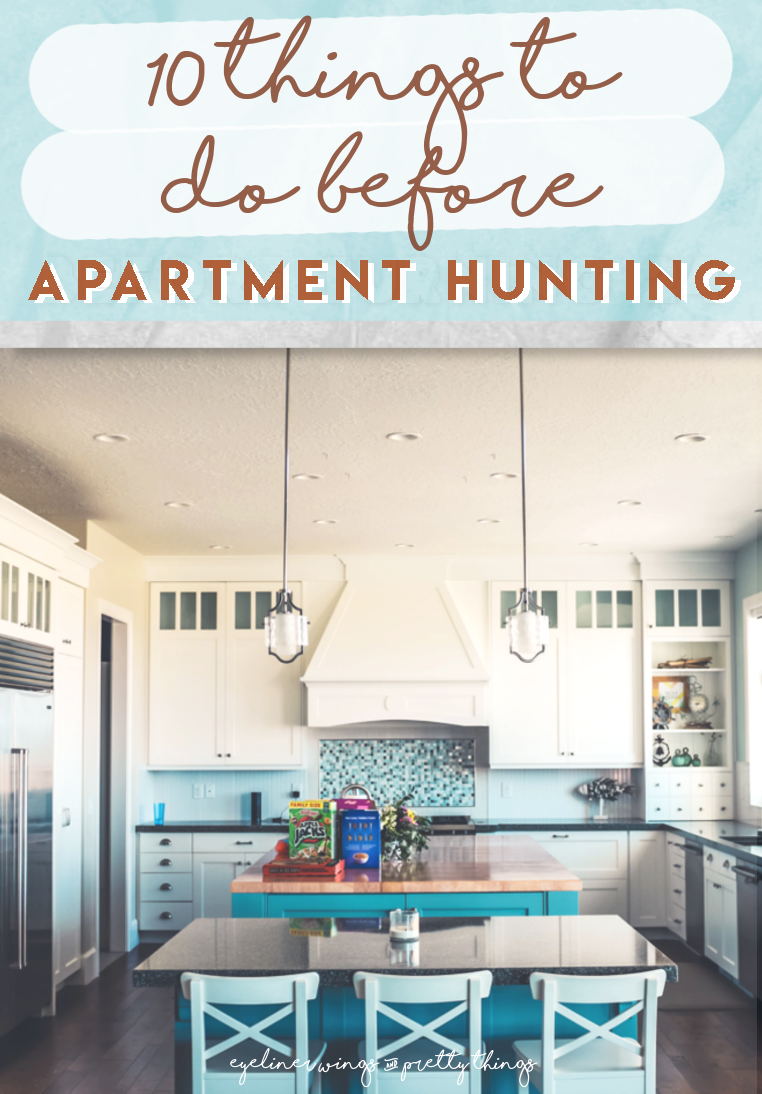
Hello! Long time no see. So much has happened! I’m moving!
Just last week I signed the lease on my first-ever actual apartment. I lived away for four years while I was in college, but that was on-campus housing…so this is my first apartment with a lease and landlord and all.
I’m moving with my boyfriend (it’s his first official apartment as well) and from finalizing the choice to live together to signing the lease, it took us less than 30 days, which was a lot quicker than we anticipated!
I think part of the reason the process went so quickly is that we kept a spreadsheet and, once we figured out the area we were interested in, became very determined to take advantage of the lower rent prices happening right now amid the ongoing pandemic.
Still, there are plenty of things I’m glad I did before fully diving into the apartment hunt.
Here are the best things to do before looking for an apartment, based on my experience.
1. Check your credit score (and have whoever you’re moving with do the same).
There are plenty of ways to do this, whether online or through a credit card app. Many listings require that you have a certain credit score, and it always works in your favor if you have good credit because landlords will be more likely to accept your application.
My boyfriend and I checked our credit scores early on and, since they were good, I dropped them into conversations with listing agents. I found that by mentioning our credit, listing agents and realtors were more likely to quickly respond and want to help me find the perfect spot.
If your credit is on the lower end, you may want to look into improving it before diving into the apartment hunt otherwise it may be difficult for you to get your application accepted.
2. Calculate your monthly income before and after taxes.
For many places, your monthly income (combined if you’re moving with someone else) must be a certain amount more than the monthly rent. From my experience, landlords typically want renters to be making at least three times the monthly rent. This pre-tax number will help you figure out which apartments you’d likely get accepted for.
BUT you also want to see how much you make after taxes and after essential expenses (like pet food, groceries, insurance, 401k) each month. This post-tax and post-essentials number will help you figure out which apartments you’d comfortably afford. If, after taxes, you make $2,000 a month but your half of the apartment you want to rent is $1,500 a month and your essentials/utilities will cost around $500 you’ll be spending all of your paycheck on rent and basics and be unable to put away any savings.
Make sure you’re comfortable with the amount of money you’d have to spend and be able to save.
3. Figure out your true non-negotiables.
We all have dreamy things we’d love to have in our apartments. For example, I’d love to have a walk-in closet, central A/C, and a private yard. But those things were not make or break for me. They’d just be pretty cool.
Before looking for apartments, my boyfriend and I sat down and discussed what our apartment NEEDED to have. These are things that we really didn’t want to live without.
Eventually, we narrowed it down to three things: the apartment had to allow cats (I have two), it had to be no more than 15 minutes from the local train (I will be back to commuting to work in a few months), and it had to have laundry in the building or in the unit (we didn’t want to deal with laundromats).
Knowing these three must-haves helped us rule out some apartments without even having to visit them.
4. Download all of the apps and check all of the websites.
I used Zillow, StreetEasy, and HotPads to find most listings and schedule viewings. I found Zillow to be the most user-friendly, but none of these sites/apps are foolproof.
Be sure to turn on alerts for apartments that are in your desired price range with your desired must-haves.
5. Know how to use the apps smartly, too.
On these apps, if you check off “cat-friendly” you’ll typically end up not being able to see dozens of apartments that are actually listed as “no pets” but are cat friendly if you ask or explain your situation. The same sort of guideline goes for if you want a building with laundry (some listings just don’t mention it).
In my experience, most listings aren’t very thorough or accurate. In every case, I messaged the listing agent and asked if they allowed cats and had laundry in the building. Sometimes the answer was no, but almost every listing (including my soon-to-be apartment) said “NO PETS” in the listing description. My cats are coming with me, with permission!
Lesson? If I had checked the “cats allowed” filter on the apartment-hunting sites, I never would’ve even looked at or found the apartment I ended up with or dozens of other viable ones.
Depending on the market, it may also be worth looking at apartments $100 or $200 more than you’re willing to pay in case the landlords would be open to negotiating. Also, be open to visiting listings that sound great but have horrible photos (bad angles, too close up). Sometimes it’s a hidden gem that was just not listed well.
When in doubt, just message the people who listed the apartments and ask questions. Speaking of….
6. Type out a basic message to send to listings you’re interested in and don’t be afraid to use it.
I suggest being very upfront and focusing on the non-negotiable features you’re looking for that I mentioned earlier.
I kept this message in my notes app and sent it to most listings I wanted to view or learn about, with a few tweaks. Here’s what mine sort of looked like:
Hi! My boyfriend and I, both with credit scores over #, are interested in this listing. I wanted to check if my two cats would be allowed in the building and confirm/see if the building had laundry in the building or unit. If so, we’d love to schedule a viewing this weekend. Please email me at TK or text me at TK!
Of course, no need to drop your credit scores but I found doing so got me a quicker response. Just be sure to ask your questions and state your musts. Even though most people who replied to me ignored key bits of my message it was worth sending it because some did answer my questions.
Sometimes the listings said they had laundry but they really meant that there was a laundromat 2 minutes away. Oftentimes they said no pets but would allow my cats (sometimes for an added fee). It never hurts to ask!
7. Make a spreadsheet.
Anyone who knows me saw this one coming! The first thing I did was make a color-coded spreadsheet. On it, we tracked the apartments we were interested in and had reached out to. We wrote down the apartment address, its rent price, distance from the train, square footage, any special features (outdoor access/bonus room/ceiling fans), how long it’s been on the market, etc.
If the apartment got filled or didn’t have any of our basics, we’d turn it red on the list so we’d know to rule it out in case we came across the listing once more. If it had potential and we scheduled a visit, it turned yellow.
Other parts of the spreadsheet included the paperwork we’d need to apply, things we need to do before moving in (get renter’s insurance, register for utilities), and lists of things we need to buy (a couch, router, etc).
8. Research potential neighborhoods.
My boyfriend and I started out knowing that we wanted to live somewhere where we’d be able to use his car, but also somewhere that was quite walkable. We knew we had to be near New York City, but knew we didn’t want to live in New York City.
We didn’t quite have a clue, so we began asking friends IRL and strangers on Reddit what sort of neighborhood in New Jersey or Connecticut they might recommend. With our budget in mind, Connecticut was quickly ruled out. And after a bit more research, we narrowed down the city we wanted.
And after viewing a few different neighborhoods within the city in person, we narrowed down the neighborhood, too.
It’s always good to see the place in real life before really deciding where you want to live, if possible. For us, seeing the city we’d set our sights on and then seeing one we’d originally deemed out of reach made us change our mind. And a bit of extra research helped us realize, too, that we could afford our dream neighborhood by stretching our budget and making a few compromises.
9. Make a viewing plan.
Obviously viewing apartments was less-than-ideal in a pandemic but we knew we did not want to rent something without seeing it.
We had two apartment viewing days a week apart. For these, we booked a bunch of viewings close together in the same neighborhood and tried to make the most of our time and paid parking. Make sure you bring a mask and bundle up if you’re looking in the winter!
10. Be prepared to make an offer.
When going on the hunt, make sure you’re prepared to potentially make an offer. Don’t let something good pass you by!
As soon as I stepped into the apartment we ended up getting, I knew it was the one. It felt like a “Say Yes to the Dress” moment. Although my boyfriend and I had been expecting to move a month or so later, we loved the place so much and knew we wanted to put in an application and offer immediately.
We viewed around 15 apartments or so, and this one was just perfect. We made an offer a few hours after we saw it. Within a few days (and many, many hours of stress), it was ours.






